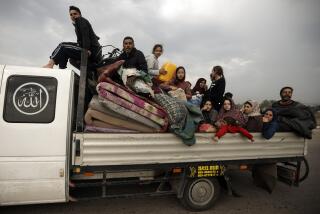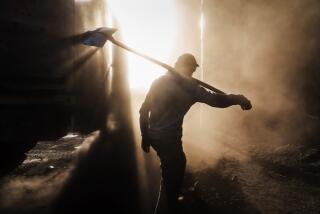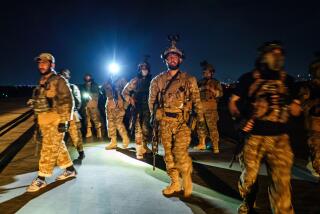Gun Battle Starts Attack on Cave Lair
- Share via
JALALABAD, Afghanistan — The long-awaited ground attack on suspected terrorist hide-outs in northeastern Afghanistan got underway with a gun skirmish Tuesday, as the Pentagon challenged persistent reports that the effort to flush Osama bin Laden from his rumored bunker complex in the mountainous region has caused widespread civilian casualties.
Afghan forces trekked into the rugged foothills of the White Mountain range, which quaked under heavy airstrikes for the fourth day in a row. U.S. bombers have relentlessly pounded the snowy mountains near the hamlets of Mawal and Tora Bora, where U.S. intelligence reports suggest that Bin Laden and members of his Al Qaeda network have taken refuge in a multistory underground bunker built during the Soviet occupation of Afghanistan.
The American airstrikes killed 15 Al Qaeda members early Tuesday, anti-Taliban officials said. Commanders in nearby Jalalabad also said they had received word that Bin Laden’s personal physician and lieutenant, Ayman Zawahiri, was injured in a bombing attack in a nearby valley. But U.S. officials said they could not confirm the report and privately voiced skepticism.
Zawahiri, a 50-year-old Egyptian doctor and founding Al Qaeda member, is believed to be Bin Laden’s most important aide. He reportedly provides much of the ideological and strategic grounding for Bin Laden’s war against the West.
As many as 2,000 Al Qaeda fighters fled to the Tora Bora hide-out last month as the Taliban’s grip on northeastern Afghanistan slackened. Many of the cornered terrorists are Arabs, Uzbeks, Chechens and other foreigners whom Defense Secretary Donald H. Rumsfeld called “fanatical dead-enders” apparently determined to fight to the death.
At the Pentagon, officials reiterated that they have been unable to confirm reports that the bombing of apparent Al Qaeda hide-outs has killed dozens of Afghan civilians and said the targets bombed by U.S. forces were the intended ones. Rumsfeld compared estimates of the dead to early tallies of as many as 10,000 at the World Trade Center on Sept. 11, which later proved to be more than double the actual number.
“If we cannot know for certain how many people were killed in lower Manhattan, where we have full access to the site, thousands of reporters, investigators, rescue workers combing the wreckage, and no enemy propaganda to confuse the situation, one ought to be sensitive to how difficult it is to know with certainty, in real time, what may have happened in any given situation in Afghanistan, where we lack access and we’re dealing with world-class liars,” Rumsfeld told reporters.
Senior Defense officials speculated that the dead might include relatives of Taliban and Al Qaeda members.
Although the combination of U.S. airstrikes and opposition ground troops has swept across every major city in Afghanistan but the Taliban’s spiritual stronghold of Kandahar in the south, pockets of resistance continue to threaten allied forces.
The small gatherings pose heightened risks for anti-Taliban fighters and the 1,500 to 2,000 U.S. Special Forces and other ground troops, Rumsfeld said.
In an incident underscoring his comments, a U.S. soldier was shot in the chest Tuesday while assisting opposition forces near Kandahar, the U.S. Central Command in Tampa, Fla., reported. The soldier, whose name was withheld, was said to be in stable condition.
“There are pockets of resistance, and there are also people floating in the general population who are armed and dangerous,” Rumsfeld said. “It’s not an orderly situation, and there are risks that will exist for Americans on the ground in Afghanistan, probably to a greater extent going forward than was the case in the past.”
Gen. Richard B. Myers, chairman of the Joint Chiefs of Staff, said U.S. Marines based less than 80 miles from Kandahar have begun destroying communication links used by the fading regime, though he declined to elaborate on their methods. However, Rumsfeld all but ruled out binding the estimated 1,200 Marines in the region to Pushtun opposition groups in a ground battle to take Kandahar.
Anti-Taliban forces in southern Afghanistan fighting to capture Kandahar’s airport ran into heavy resistance for the third straight day Tuesday. They managed to fight their way inside the airport perimeter but failed to subdue a large group of Arabs defending the facility.
Mohammed Yusef Pushtoon, an aide to anti-Taliban commander Gul Agha Shirzai, said their fighters had pushed their way into a southern corner of the airport and occupied a guard tower before dark Tuesday. He said that three members of Shirzai’s force had been killed in fierce fighting Monday and that the advance was moving extremely slowly to prevent further casualties.
“Resistance is very stiff,” Pushtoon said. “There are hundreds of Arab defenders, and they are fighting extremely hard.”
As fighting raged on the ground, U.S. warplanes bombed the airport with some of the most intensive airstrikes of the campaign, apparently in an attempt to weaken the Arab defenders.
Northwest of Kandahar, another anti-Taliban force under the command of tribal chief Hamid Karzai made small gains Tuesday, meeting little resistance as it moved close to the town of Arghandab.
In the northeast of the country, the opposition fighters began a cave-by-cave search for Bin Laden.
“We must start the war against these people,” said Haji Mohammed Zaman, commander of anti-Taliban forces in northeastern Afghanistan. Before sending soldiers, the commander dispatched tribal elders to entreat Al Qaeda to abandon the mountains. By Tuesday, he said, the talks had fizzled. “Practically,” he said, “we must fight.”
A light gun skirmish broke out at the edge of the broad, woodsy swath of mountains. Al Qaeda forces retreated higher into the hills to escape the opposition forces, who promptly seized an abandoned tank, provincial security chief Hazrat Ali said.
By Tuesday night, more than 1,000 opposition soldiers had gathered at the edge of Tora Bora. Their numbers will swell to 3,000 over the next two days, their commanders said. The warriors plan to lay siege to the hide-outs by cutting off the water supply and blocking the road to Jalalabad. “Without water,” Zaman said, “life is very difficult.”
The mountain hide-out will probably prove a daunting target. Built with U.S. support during the 1980s war against the former Soviet Union, Tora Bora boasts heat, electricity and camouflage of trees and rocks. During the war against the Soviets, moujahedeen dug themselves into the caves and held off invading soldiers for years.
The Al Qaeda network has broken off into groups of a dozen or more men scattered throughout various caves in readiness for battle, the anti-Taliban commanders explained. Any escape up the mountains will be hindered by the thick snows of winter, they said. The mountains could be flushed of foreign fighters within a few weeks, they added.
“We’ll follow our own strategy of guerrilla war,” said Ali, who battled Soviet forces in Tora Bora more than a decade ago. “We know how to do that.”
Stack reported from Jalalabad and Hendren from Washington. Times staff writer Tyler Marshall in Quetta, Pakistan, contributed to this report.
More to Read
Sign up for Essential California
The most important California stories and recommendations in your inbox every morning.
You may occasionally receive promotional content from the Los Angeles Times.













